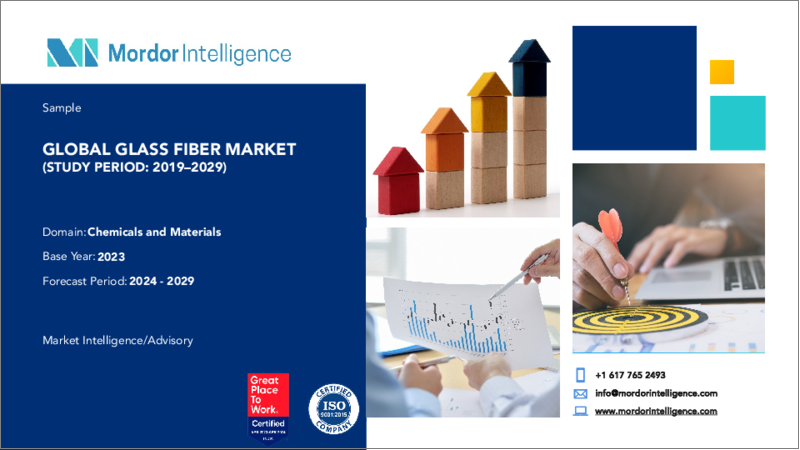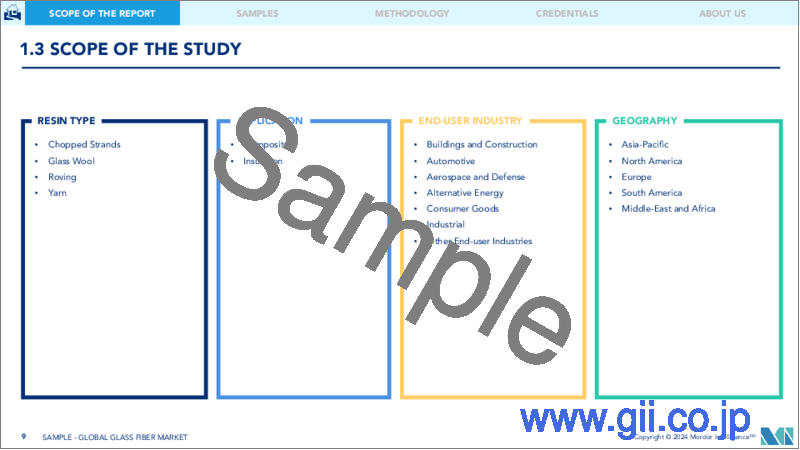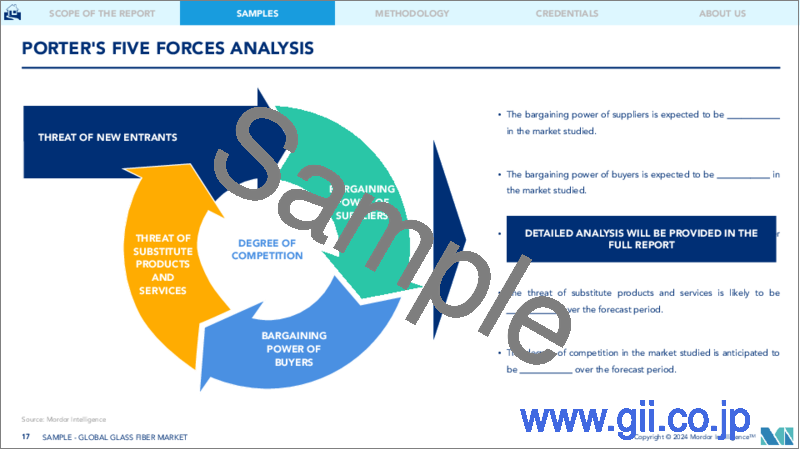|
|
市場調査レポート
商品コード
1196862
ガラス繊維市場- 成長、動向、予測(2023年-2028年)Glass Fiber Market - Growth, Trends, and Forecasts (2023 - 2028) |
||||||
|
● お客様のご希望に応じて、既存データの加工や未掲載情報(例:国別セグメント)の追加などの対応が可能です。 詳細はお問い合わせください。 |
|||||||
| ガラス繊維市場- 成長、動向、予測(2023年-2028年) |
|
出版日: 2023年01月23日
発行: Mordor Intelligence
ページ情報: 英文 120 Pages
納期: 2~3営業日
|
- 全表示
- 概要
- 目次
ガラス繊維市場は、予測期間中にCAGR4%超で成長すると予測されています。
COVID-19は、ロックダウン規制、労働力不足、生産停止などのために、2020年の建築・建設業界に悪影響を及ぼしました。建築・建設業界はガラス繊維の主要なエンドユーザーであるため、このことはガラス繊維市場に影響を及ぼしました。しかし、同産業からの需要は2021年に回復し、今後数年間は成長する可能性が高いです。
主なハイライト
- 中期的には、調査対象市場の成長を促進する主な要因は、建設業界からの高い需要と自動車業界からのガラス繊維複合材の需要増加です。
- 反面、売上高利益率の低さ、炭素繊維やロックウールとの競合が、予測期間中のガラス繊維市場の成長を抑制する可能性があります。
- 軽量のガラス繊維強化プラスチック(GFRP)複合材料の用途の成長と、風力エネルギー分野におけるガラス繊維複合材料の需要の増加が、予測期間中に調査した市場の機会として作用する可能性が高いです。
- アジア太平洋地域は市場を独占し、予測期間中に最も高いCAGRで推移すると予想されます。
ガラス繊維の市場動向
建築・建設分野からの需要増加
- ガラス繊維は、ガラス繊維強化コンクリート(GRC)という形で、環境に優しい建設材料として使用されています。GRCは、重量や環境上の問題を引き起こすことなく、建物に堅牢な外観を与えます。
- セメントミックスにガラス繊維を使用することで、腐食に強い頑丈な繊維で材料を補強し、GRCをあらゆる建設要件に対応する長寿命なものにします。GRCは軽量なため、壁や基礎、パネル、クラッドなどの建設がより簡単かつ迅速に行えます。
- 米国は世界でも有数の建設業を有する国です。米国国勢調査局および米国住宅都市開発省によると、2022年10月の1カ月間の民間新築住宅の完成件数は133万9000件で、10月の民間住宅着工件数は142万5000件でした。
- ユーロスタットによると、2022年5月の建設部門の生産は、2022年4月の生産と比較して、ユーロ圏で0.4%、EUで0.8%増加しました。2021年5月と比較すると、建築工事は3.1%増加しました。
- このような建築・建設分野の成長に伴い、予測期間中にガラス繊維の需要が増加すると予想されます。
アジア太平洋地域が市場を独占する
- アジア太平洋地域の建設部門は世界最大であり、特に中国、インド、日本といった国々の商業ビル部門の成長により、予測期間中にガラス繊維市場の需要が高まると予想されます。
- 中国は建設メガブームの真っ只中にあります。同国は世界最大の建築市場であり、世界の全建築投資の20%を占めています。2030年までに13兆米ドル近くを建築物に費やすと予想されています。国家発展改革委員会(NDRC)によると、上海の計画では今後3年間で387億米ドルの投資が予定されています。一方、広州では、新たに16のインフラプロジェクトに署名し、投資額は80億9,000万米ドルとなっています。
- 中国は、2035年までに空港の数を450に増やすという長期計画を掲げています。中国の第14次5カ年計画(2021-25年)は航空分野に重点を置き、今年の計画では新たに30の民間空港を開設し、旅客数は43%増の20億人とする予定です。
- また、アジア太平洋地域は、世界の生産シェアの60%近くを記録する最大の自動車生産拠点です。アジア太平洋地域では、中国とインドが自動車の主要生産国です。OICAによると、中国は世界最大の自動車生産拠点であり、2021年の自動車生産台数は2,608万台で、昨年の2,523万台と比較して3%の増加を記録しています。さらに、中国自動車工業会(CAAM)によると、2022年の最初の7カ月間で、同国は1457万台の自動車を生産し、前年比31.5%の成長率を記録しています。
- インドは今後7年間で住宅に約1兆3,000億米ドルの投資を行い、その間に6,000万戸の新規住宅建設を示す可能性が高いです。21年度のFDI流入額817億2,000万米ドルのうち、インフラは13%のシェアを占めています。
- また、2025年に大阪で万国博覧会が開催されることから、日本の建設業界も活況を呈すると予想されます。さらに、八重洲再開発プロジェクトと61階建て390mのオフィスタワーがそれぞれ2023年と2027年に完成する予定であり、これにより市場は拡大すると見られています。
- 全体として、様々なエンドユーザー部門への継続的な投資は、アジア太平洋地域におけるガラス繊維の消費を大きく後押しするものと思われます。
ガラス繊維市場の競合他社分析
ガラス繊維市場は、統合された性質を持っています。市場の主要なプレーヤーには、(順不同)オーエンスコーニング、サンゴバンVetrotex、ジョンズマンビル、日本電気硝子、中国Jushi、などがあります.
その他の特典。
- エクセル形式の市場予測(ME)シート
- 3ヶ月間のアナリストサポート
目次
第1章 イントロダクション
- 調査の前提条件
- 調査範囲
第2章 調査手法
第3章 エグゼクティブサマリー
第4章 市場力学
- 促進要因
- 建設業界からの高い需要
- 自動車産業からのガラス繊維複合材に対する需要の増加
- 抑制要因
- カーボンファイバーやロックウールとの競合
- 低い売上高利益率
- 業界バリューチェーン分析
- ポーターのファイブフォース分析
- 供給企業の交渉力
- 消費者の交渉力
- 新規参入業者の脅威
- 代替品の脅威
- 競合の度合い
第5章 市場セグメンテーション(市場規模(金額ベース)
- 樹脂の種類
- チョップドストランド
- グラスウール
- ロービング
- ヤーン
- 用途
- コンポジット
- 断熱材
- エンドユーザー産業
- 建築・土木
- 自動車産業
- 航空宇宙・防衛
- 代替エネルギー
- 消費財
- 工業
- その他エンドユーザー産業(エレクトロニクスなど)
- 地域別
- アジア太平洋地域
- 中国
- インド
- 日本
- 韓国
- その他アジア太平洋地域
- 北米
- 米国
- カナダ
- メキシコ
- 欧州
- ドイツ
- フランス
- 英国
- イタリア
- その他欧州
- 南米
- ブラジル
- アルゼンチン
- その他の南米地域
- 中東地域
- サウジアラビア
- 南アフリカ共和国
- その他の中東地域
- アジア太平洋地域
第6章 競合情勢
- M&A、合弁事業、協業、協定
- 市場シェア(%)**/ランキング分析
- 主要なプレーヤーが採用する戦略
- 企業プロファイル
- AGY
- ASAHI FIBER GLASS Co., Ltd.
- Binani Industries Ltd.
- Chongqing Polycomp International Corp.(CPIC)
- Johns Manville
- China Jushi Co., Ltd.
- Nippon Electric Glass Co., Ltd.
- Owens Corning
- PFG FIBER GLASS CORPORATION
- Saint-Gobain Vetrotex
- CTG Group
- TAIWAN GLASS IND. CORP.
第7章 市場機会と今後の動向
- 軽量ガラス繊維強化プラスチック(GFRP)複合材料の用途の拡大
- 風力発電分野でのガラス繊維複合材料の需要増加
The glass fiber market is projected to register a CAGR of over 4% during the forecast period.
COVID-19 adversely affected the building and construction industry in 2020 owing to lockdown regulations, shortage of labor, production halt, etc. This, in turn, affected the glass fiber market, as building and construction is a major end-user industry for glass fibers. However, the demand from the industry recovered in 2021 and is likely to grow in the coming years.
Key Highlights
- Over the medium term, the major factor driving the growth of the market studied is the high demand from the construction industry and the increasing demand for fiberglass composites from the automotive industry.
- On the flip side, the low-profit margin on sales and competition from carbon fiber and Rockwool can restrain the growth of the glass fiber market during the forecast period.
- Growth in the usage of lightweight glass fiber-reinforced plastic (GFRP) composites and increasing demand for fiberglass composite materials for the wind energy sector are likely to act as an opportunity for the market studied over the forecast period.
- Asia-Pacific region is expected to dominate the market and is also likely to witness the highest CAGR during the forecast period.
Glass Fiber Market Trends
Rising Demand from the Building and Construction Sector
- Glass fiber is used as eco-friendly construction material in the form of glass-fiber reinforced concrete (GRC). The GRC imparts buildings with a solid appearance without causing weight and environmental distresses.
- Using glass fiber in the cement mix reinforces the material with corrosion-proof sturdy fibers, which make GRC long-lasting for any construction requirement. Owing to the lightweight nature of GRC, the construction of walls, foundations, panels, and cladding becomes much easier and quicker.
- The United States has one of the world's largest construction industries. According to the U.S. Census Bureau and the U.S. Department of Housing and Urban Development, the total number of completed privately-owned new residential construction in the month of October 2022 was 1,339,000, while privately-owned housing starts in October were 1,425,000.
- According to Eurostat, in May 2022, production in the construction sector increased by 0.4% in the Euro area and 0.8% in the EU as compared to the production in April 2022. As compared to May 2021, building construction increased by 3.1%.
- With such growth in the building and construction sector, the demand for glass fiber is expected to increase during the forecast period.
Asia-Pacific to Dominate the Market
- The Asia-Pacific construction sector is the largest in the world, and its growth especially in the commercial building sector in countries like China, India, and Japan, is expected to increase the demand for the glass fiber market during the forecast period.
- China is in the midst of a construction mega-boom. The country has the largest building market in the world, making up 20% of all construction investment globally. The country is expected to spend nearly USD 13 trillion on buildings by 2030. According to the National Development and Reform Commission (NDRC), the Shanghai plan includes an investment of USD 38.7 billion in the next three years. In contrast, Guangzhou has signed 16 new infrastructure projects with an investment of USD 8.09 billion.
- China holds a long-term plan to increase the number of airports to 450 by 2035. China's 14th Five-Year Plan (2021-25) focused on the aviation sector and opened 30 new civil airports under this year's plan, and the passenger capacity is to increase by 43% to 2 billion passengers.
- Also, the Asia-Pacific region is the largest automotive manufacturing hub, registering almost 60% production share of the world. In Asia-Pacific, China and India are major producers of vehicles. According to OICA, China has the largest automotive production base in the world, with a total vehicle production of 26.08 million units in 2021, registering an increase of 3% compared to 25.23 million units produced last year. Further, according to the China Association of Automobile Manufacturers (CAAM), in the first 7 months of 2022, the country has produced 14.57 million units of cars, registering a growth rate of 31.5% year-on-year.
- India is likely to witness an investment of around USD 1.3 trillion in housing over the next seven years, during which it is likely to witness the construction of 60 million new homes. In FY21, the infrastructure activities accounted for 13% share of the total FDI inflows of USD 81.72 billion.
- The Japanese construction industry is also expected to boom as the country will host the World Expo in 2025 in Osaka, Japan. Furthermore, the Yaesu redevelopment project along with a 61-storey, 390 m tall office tower are due for completion in 2023 and 2027 respectively, which will augment the market studied.
- Overall, continuous investments in various end-user sectors are going to largely boost the consumption of glass fiber in the Asia-Pacific region.
Glass Fiber Market Competitor Analysis
The glass fiber market is consolidated in nature. Some of the major players in the market include (not in any particular order) Owens Corning, Saint-Gobain Vetrotex, Johns Manville, Nippon Electric Glass Co., Ltd., and China Jushi Co., Ltd., among others .
Additional Benefits:
- The market estimate (ME) sheet in Excel format
- 3 months of analyst support
TABLE OF CONTENTS
1 INTRODUCTION
- 1.1 Study Assumptions
- 1.2 Scope of the Study
2 RESEARCH METHODOLOGY
3 EXECUTIVE SUMMARY
4 MARKET DYNAMICS
- 4.1 Drivers
- 4.1.1 High Demand from the Construction Industry
- 4.1.2 Increasing Demand for Fiberglass Composites from the Automotive Industry
- 4.2 Restraints
- 4.2.1 Competition from Carbon Fiber and Rockwool
- 4.2.2 Low Profit Margin on Sales
- 4.3 Industry Value Chain Analysis
- 4.4 Porter's Five Forces Analysis
- 4.4.1 Bargaining Power of Suppliers
- 4.4.2 Bargaining Power of Consumers
- 4.4.3 Threat of New Entrants
- 4.4.4 Threat of Substitute Products and Services
- 4.4.5 Degree of Competition
5 MARKET SEGMENTATION (Market Size in Value)
- 5.1 Resin Type
- 5.1.1 Chopped Strands
- 5.1.2 Glass Wool
- 5.1.3 Roving
- 5.1.4 Yarn
- 5.2 Application
- 5.2.1 Composites
- 5.2.2 Insulation
- 5.3 End-user Industry
- 5.3.1 Buildings and Construction
- 5.3.2 Automotive
- 5.3.3 Aerospace and Defense
- 5.3.4 Alternative Energy
- 5.3.5 Consumer Goods
- 5.3.6 Industrial
- 5.3.7 Other End-user Industries (Electronics, etc.)
- 5.4 Geography
- 5.4.1 Asia-Pacific
- 5.4.1.1 China
- 5.4.1.2 India
- 5.4.1.3 Japan
- 5.4.1.4 South Korea
- 5.4.1.5 Rest of Asia-Pacific
- 5.4.2 North America
- 5.4.2.1 United States
- 5.4.2.2 Canada
- 5.4.2.3 Mexico
- 5.4.3 Europe
- 5.4.3.1 Germany
- 5.4.3.2 France
- 5.4.3.3 United Kingdom
- 5.4.3.4 Italy
- 5.4.3.5 Rest of Europe
- 5.4.4 South America
- 5.4.4.1 Brazil
- 5.4.4.2 Argentina
- 5.4.4.3 Rest of South America
- 5.4.5 Middle-East
- 5.4.5.1 Saudi Arabia
- 5.4.5.2 South Africa
- 5.4.5.3 Rest of Middle-East
- 5.4.1 Asia-Pacific
6 COMPETITIVE LANDSCAPE
- 6.1 Mergers and Acquisitions, Joint Ventures, Collaborations, and Agreements
- 6.2 Market Share (%)**/ Ranking Analysis
- 6.3 Strategies Adopted by Leading Players
- 6.4 Company Profiles
- 6.4.1 AGY
- 6.4.2 ASAHI FIBER GLASS Co., Ltd.
- 6.4.3 Binani Industries Ltd.
- 6.4.4 Chongqing Polycomp International Corp. (CPIC)
- 6.4.5 Johns Manville
- 6.4.6 China Jushi Co., Ltd.
- 6.4.7 Nippon Electric Glass Co., Ltd.
- 6.4.8 Owens Corning
- 6.4.9 PFG FIBER GLASS CORPORATION
- 6.4.10 Saint-Gobain Vetrotex
- 6.4.11 CTG Group
- 6.4.12 TAIWAN GLASS IND. CORP.
7 MARKET OPPORTUNITIES AND FUTURE TRENDS
- 7.1 Growth in the Usage of Lightweight Glass Fiber Reinforced Plastic (GFRP) Composites
- 7.2 Increasing Demand for Fiberglass Composite Materials for the Wind Energy Sector




